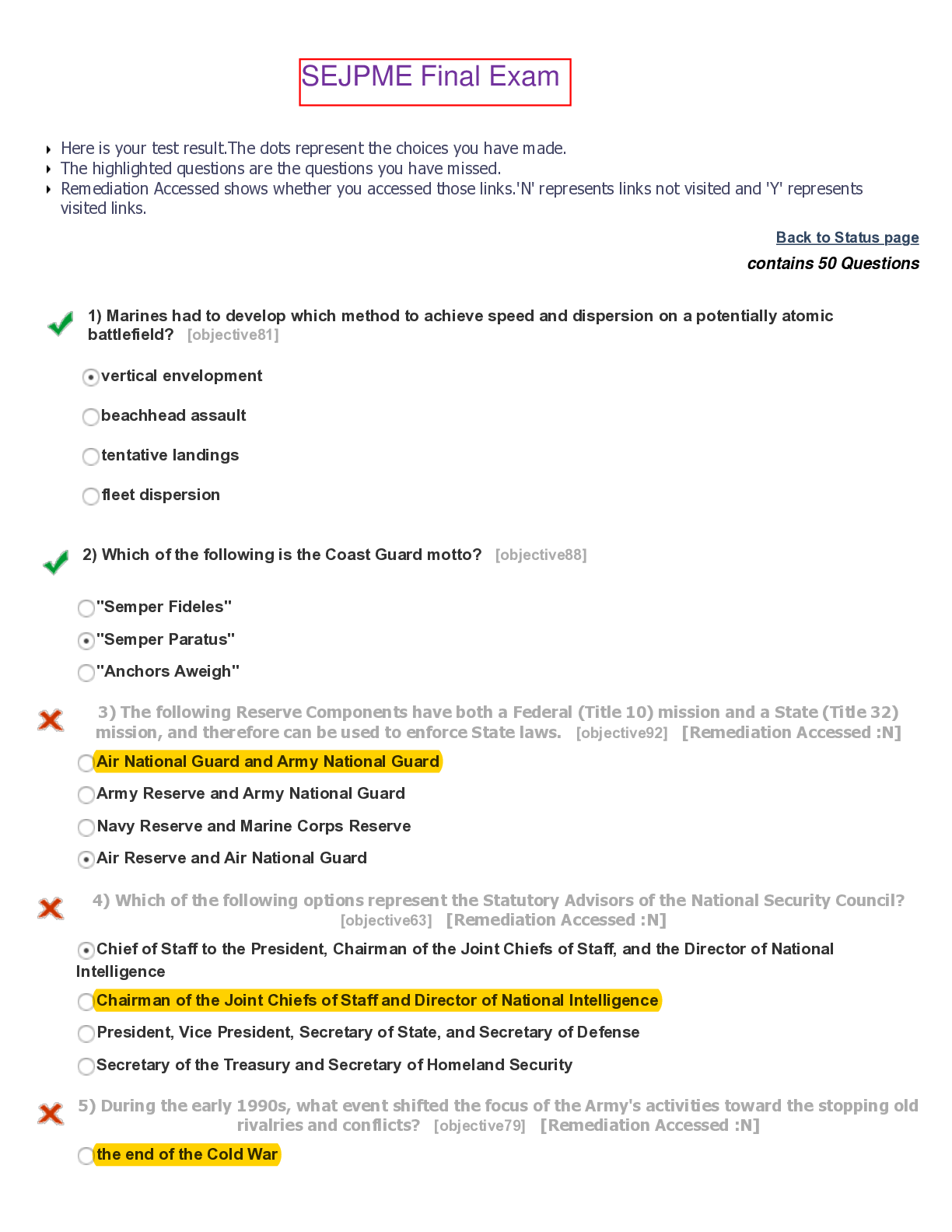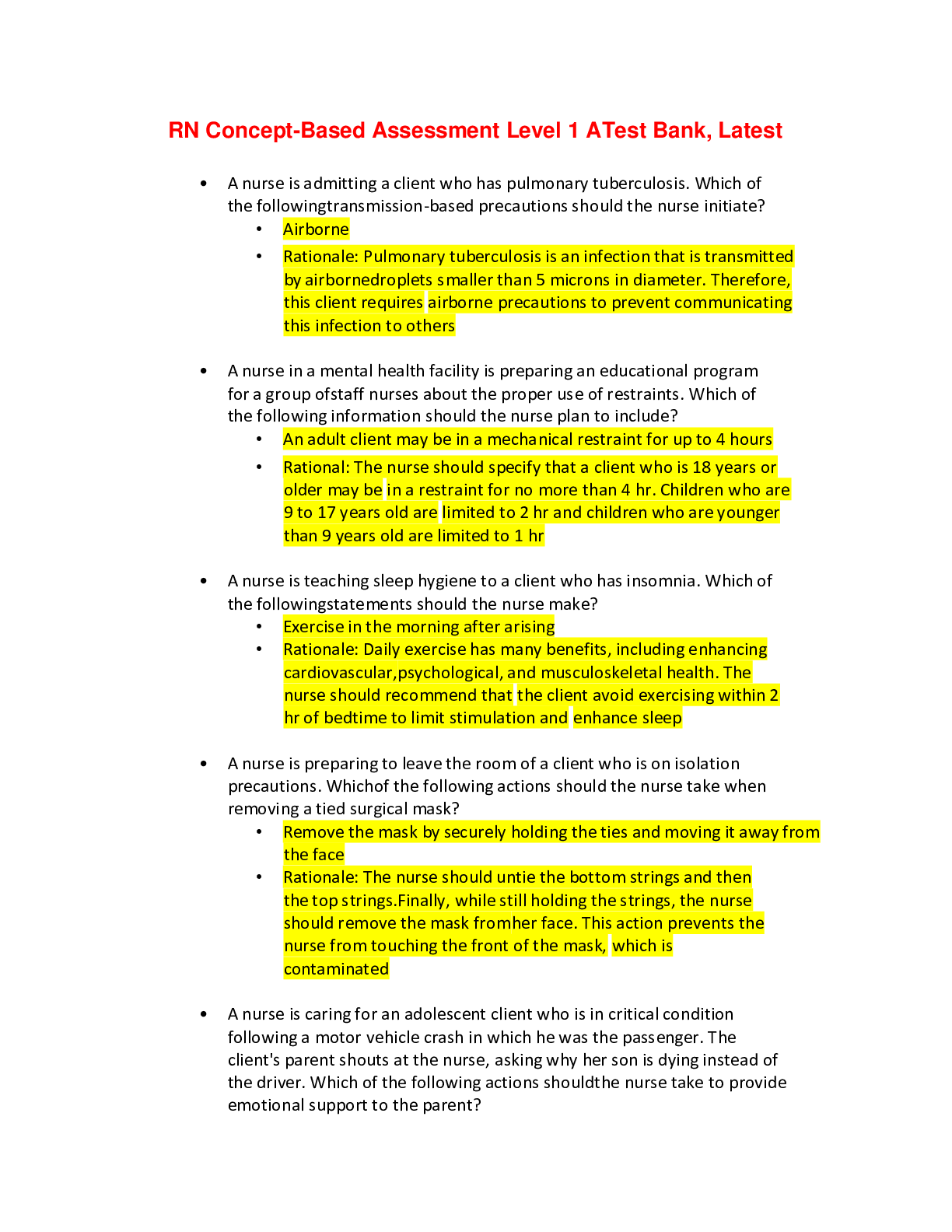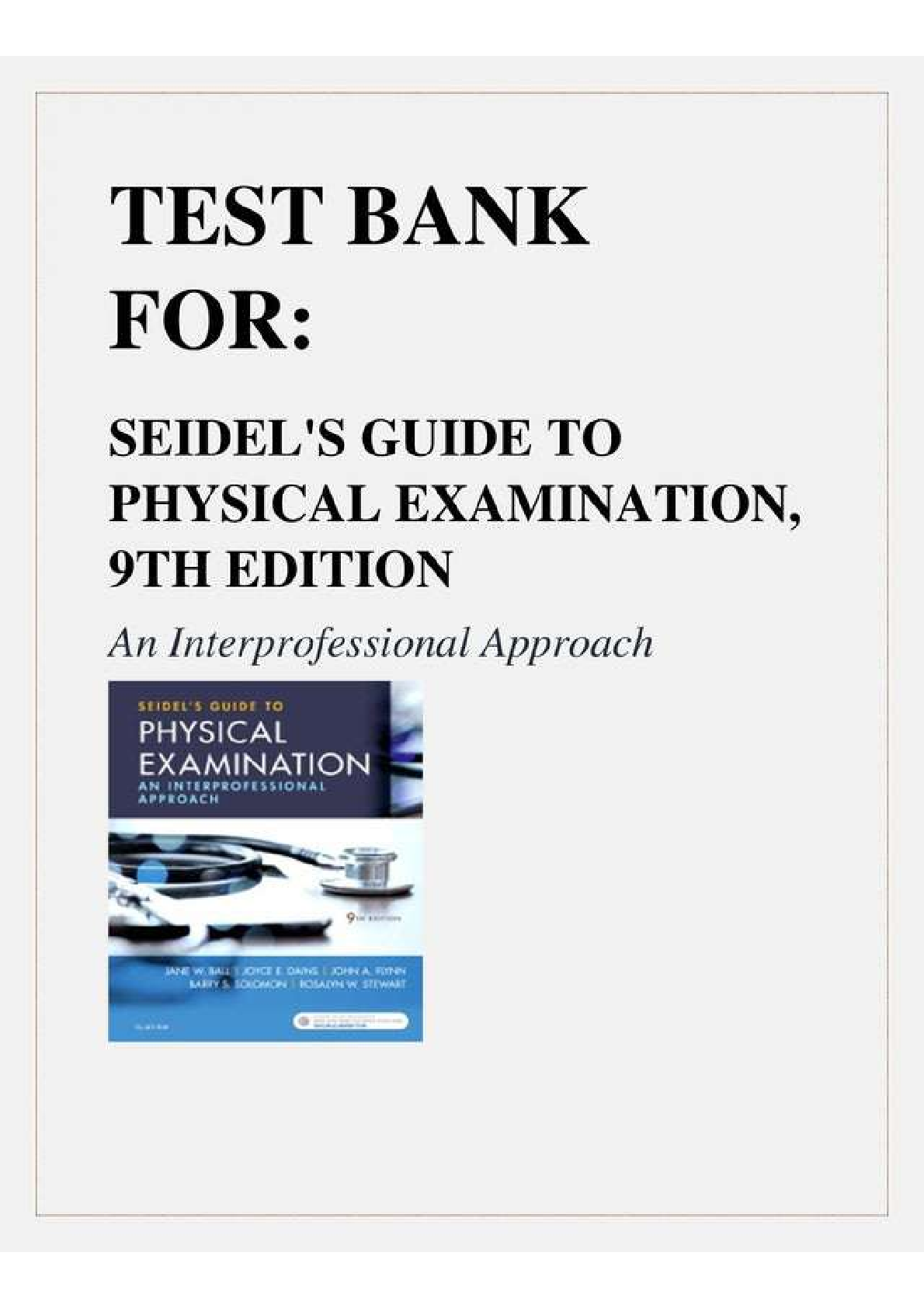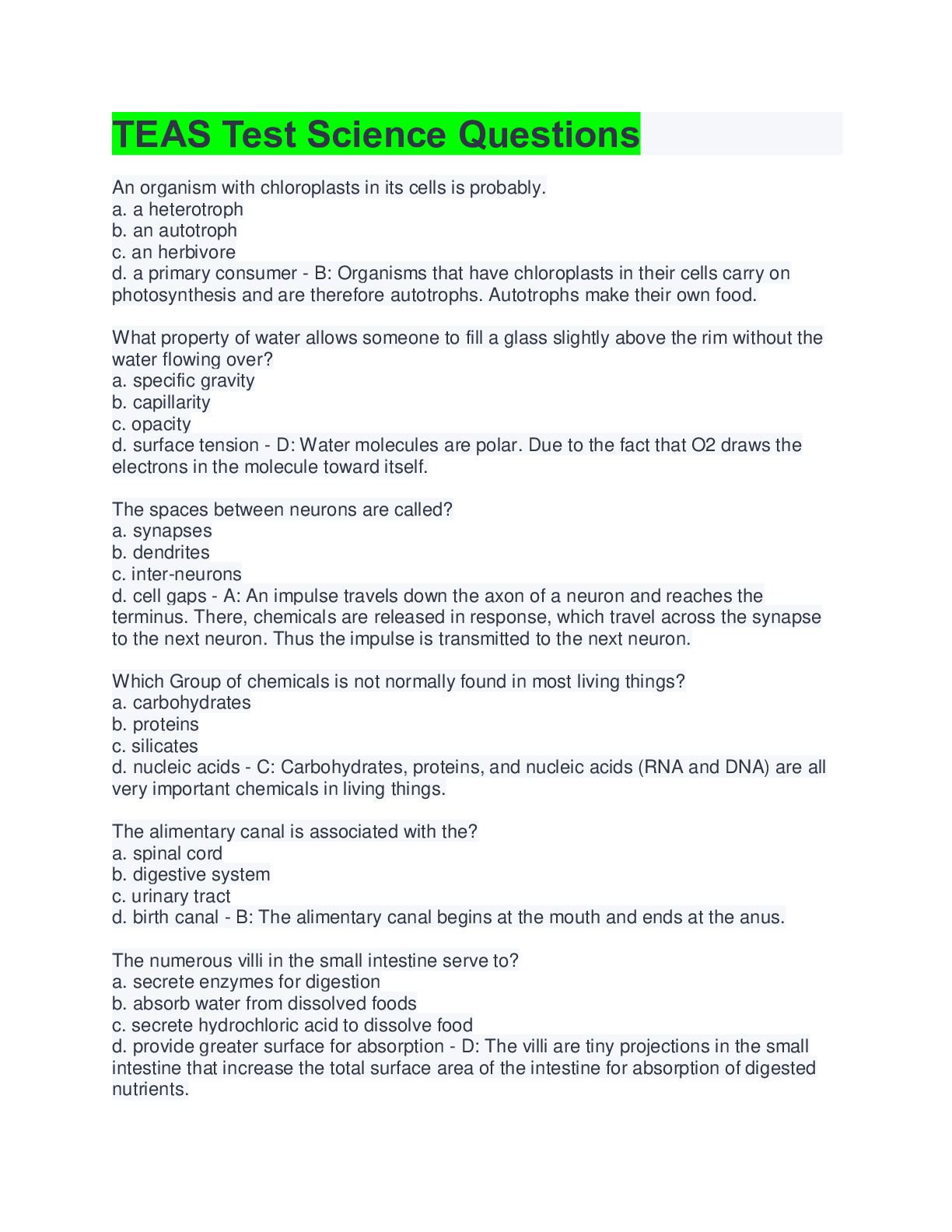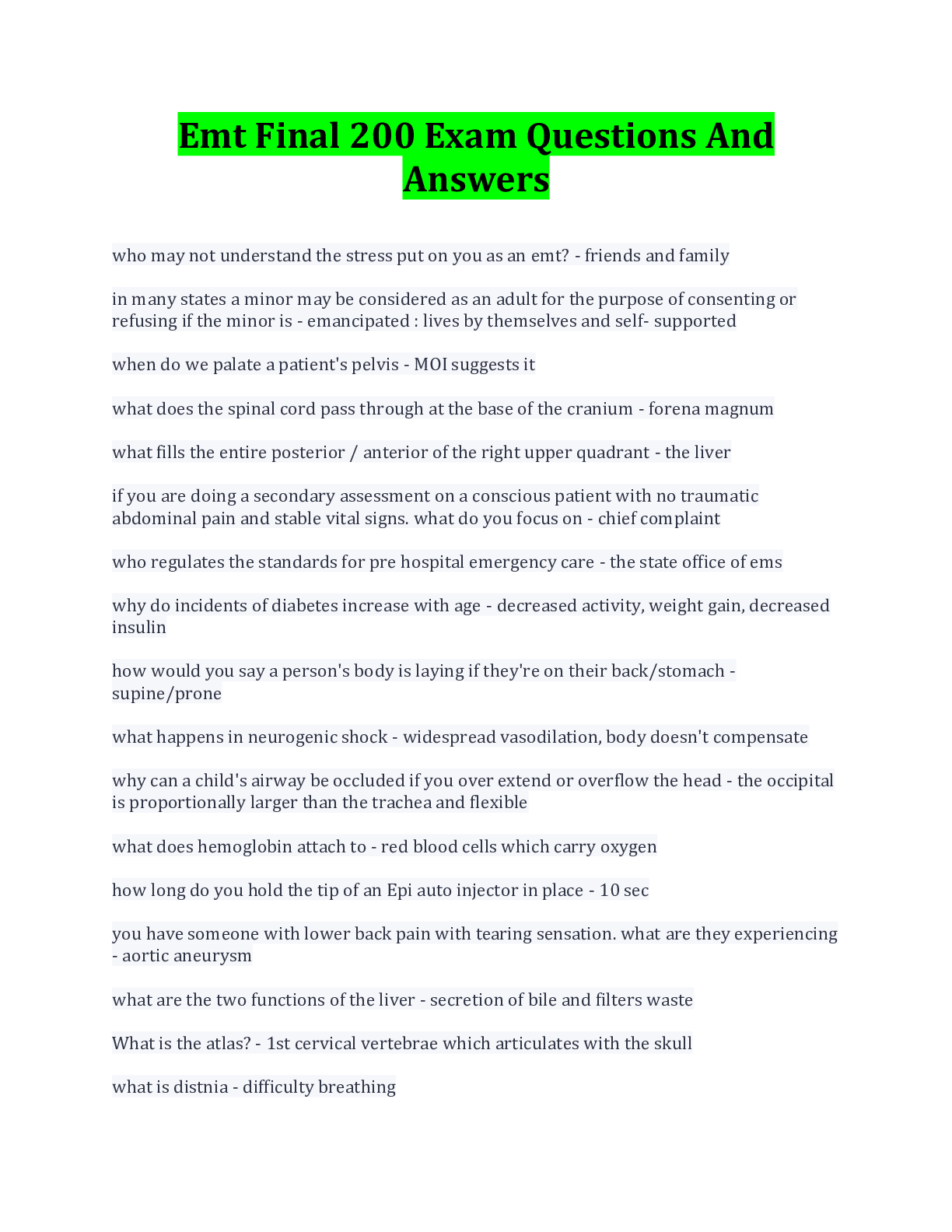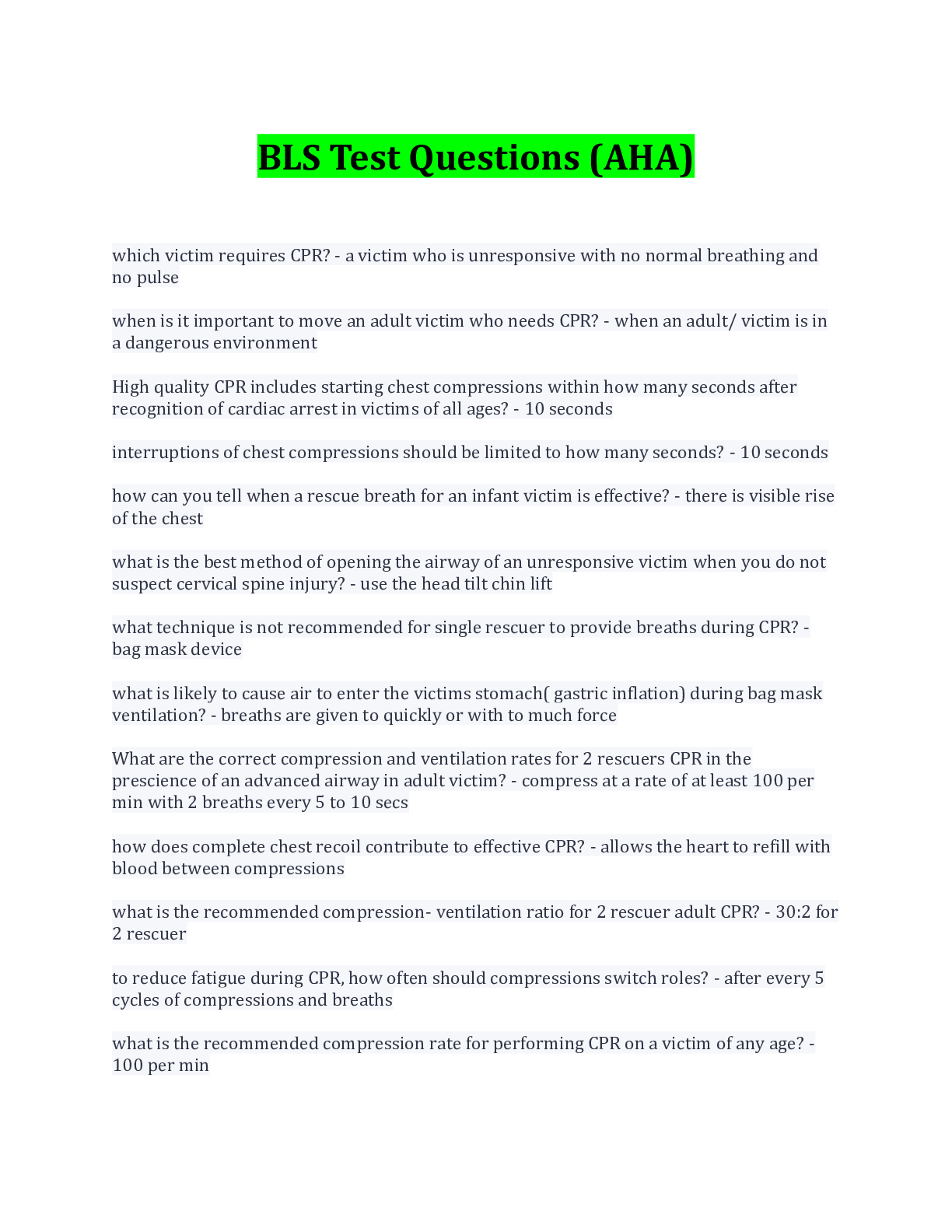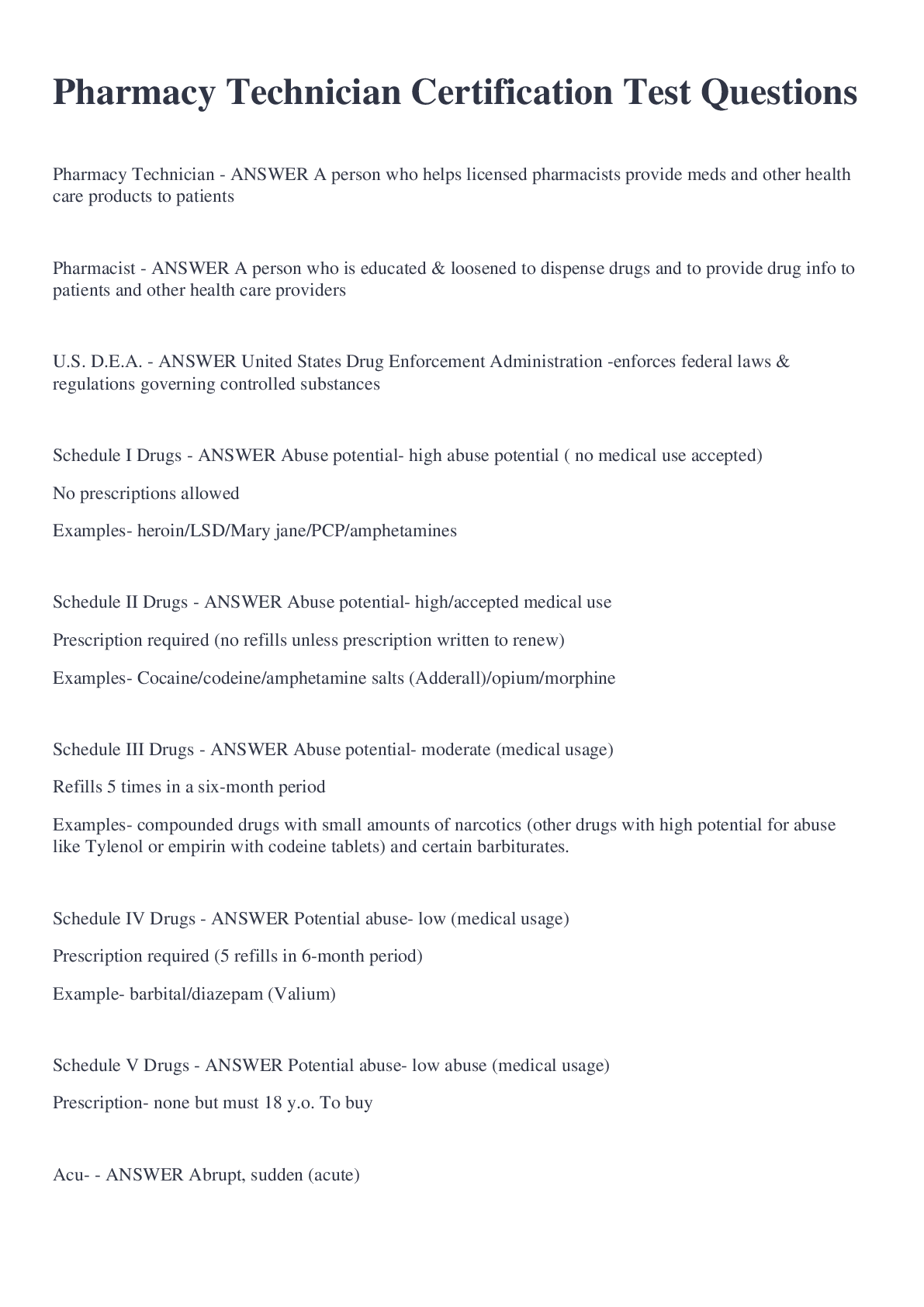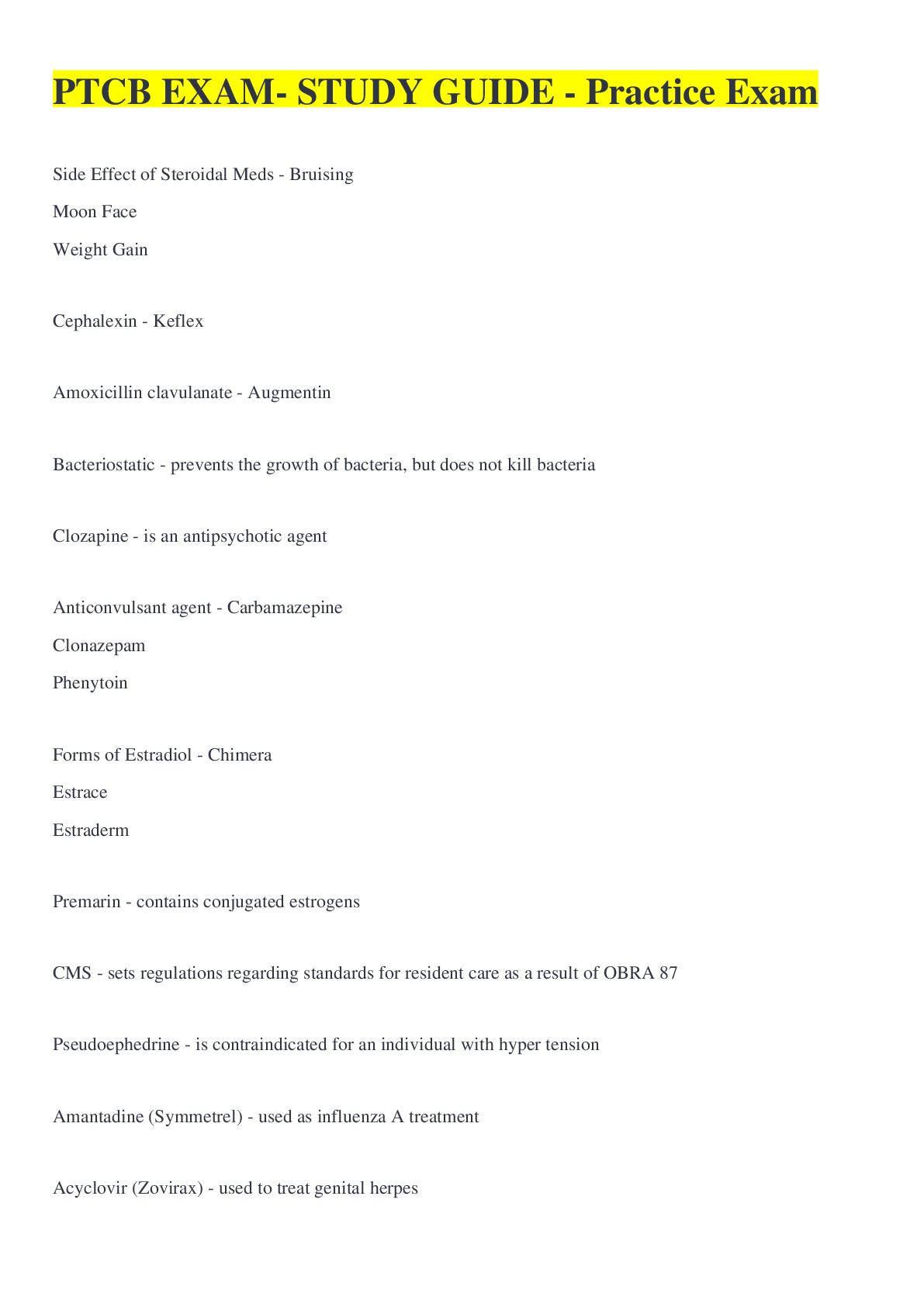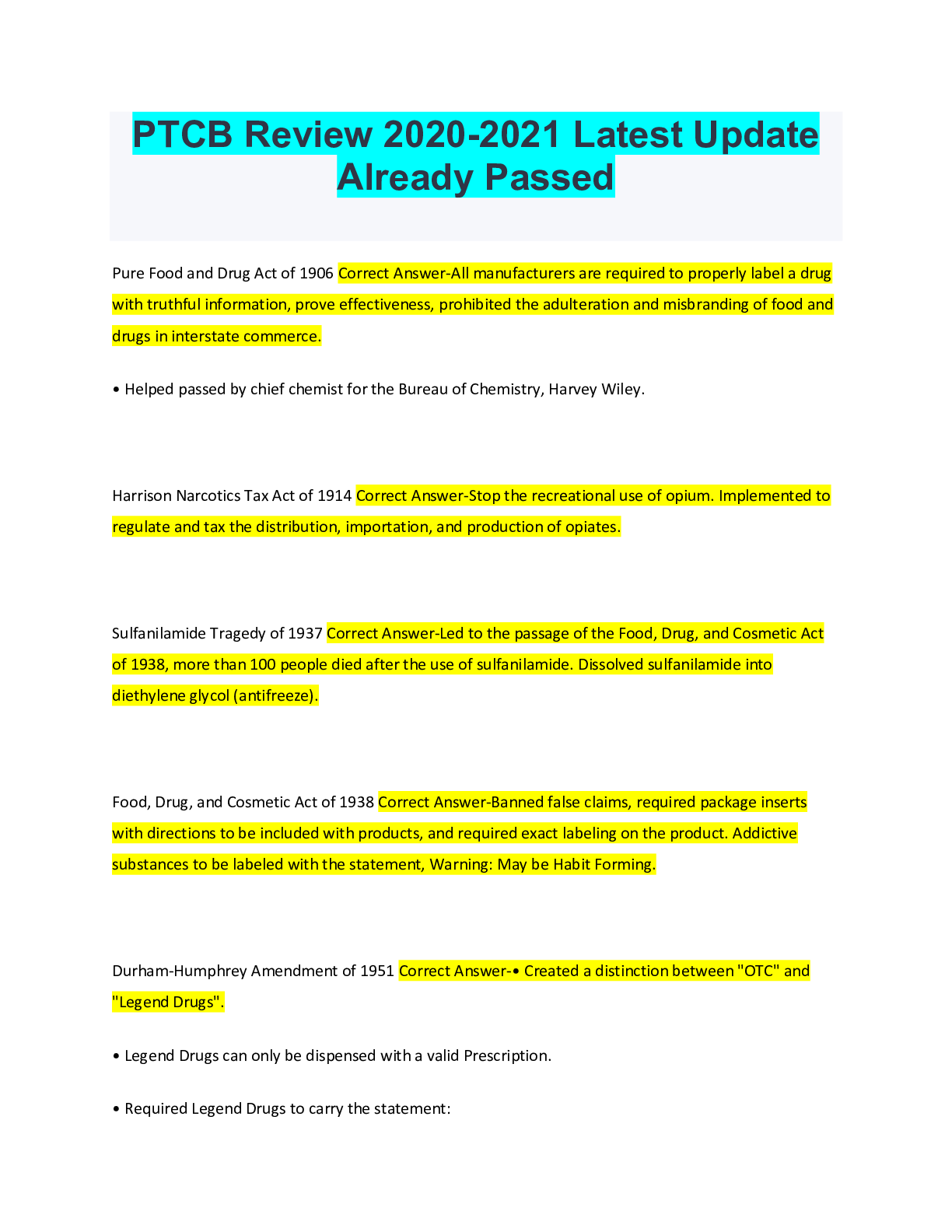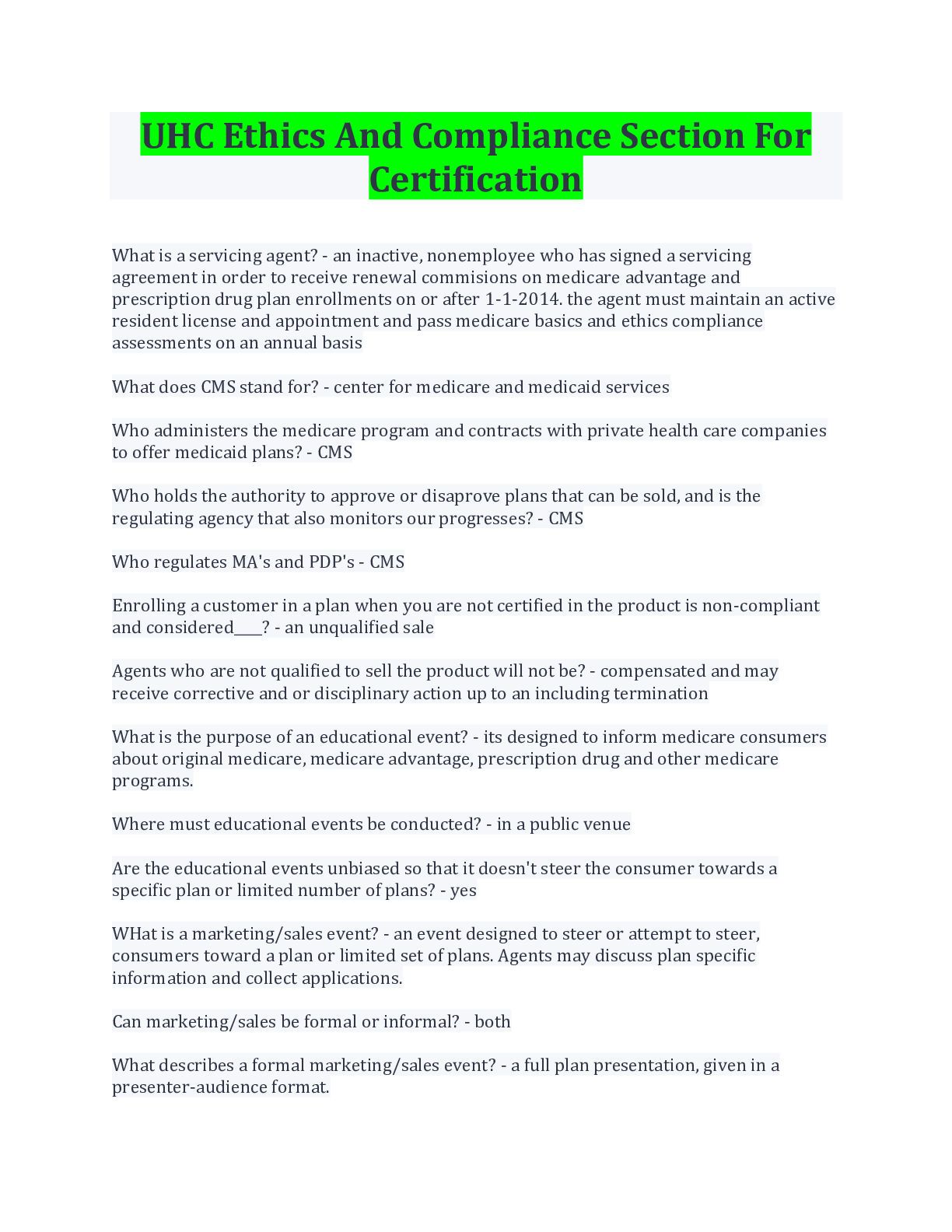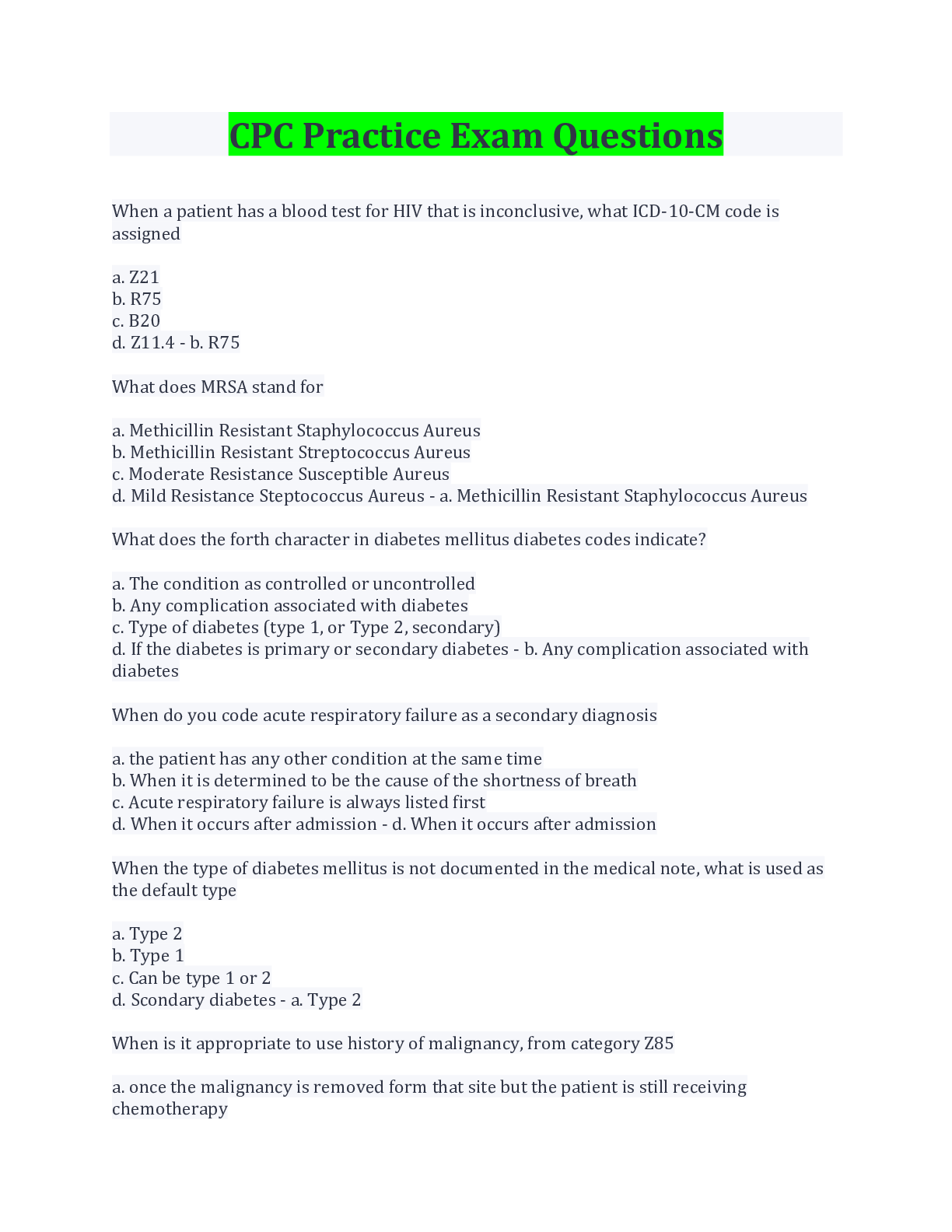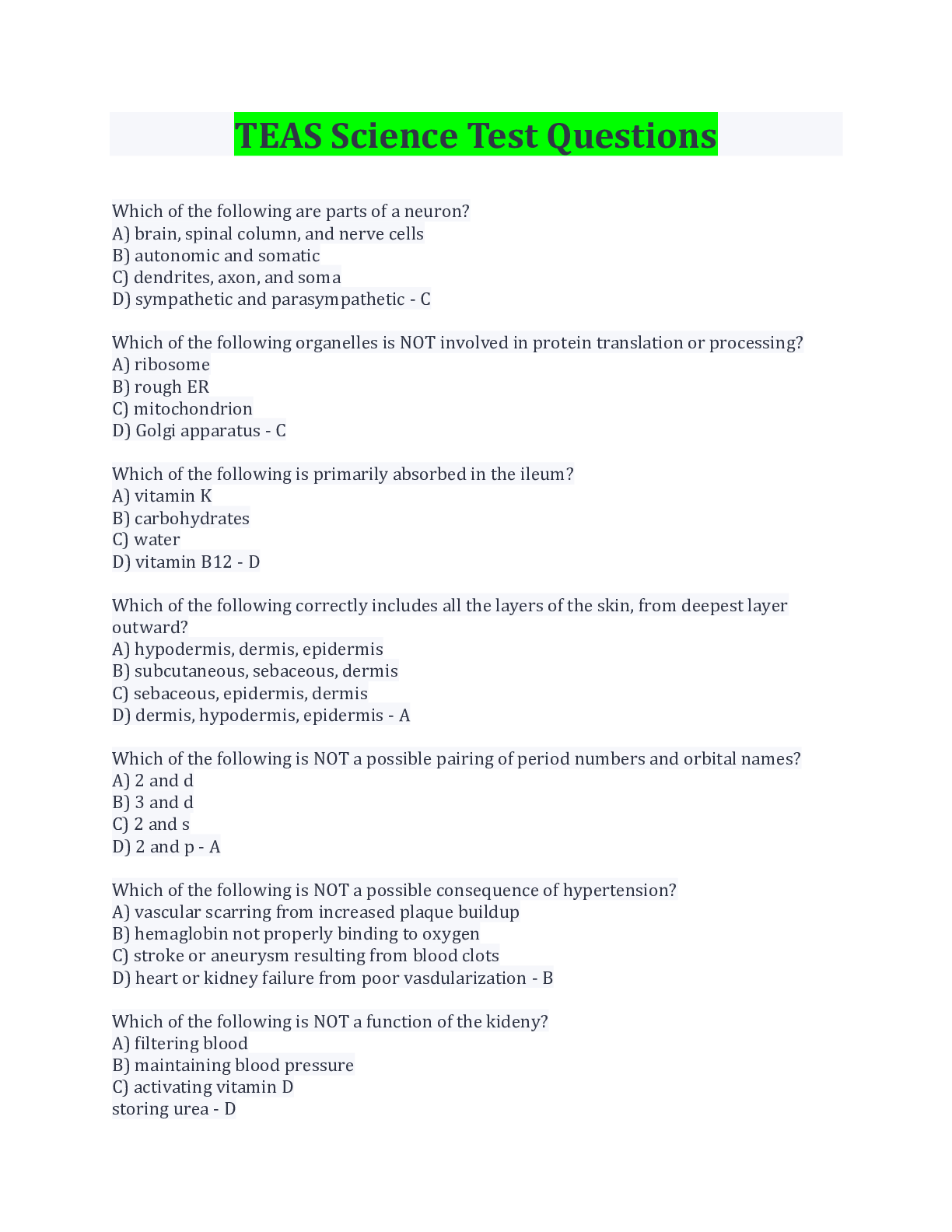*NURSING > EXAM > NURS MISC Respiratory Syncytial Virus Case Study( Complete Solution Rated A) (All)
NURS MISC Respiratory Syncytial Virus Case Study( Complete Solution Rated A)
Document Content and Description Below
Respiratory Syncytial Virus (RSV) Bronchiolitis Case Study Assessment When the nurse enters the room, she finds Emma crying in her mother’s arms. The nurse and Susan calm Emma and then the nurse... auscultates the infant’s lungs. Coarse bilateral wheezes are detected but the infant does not appear in acute distress at this time. 1.) What action should the nurse take next? A. Perform nasal suctioning. B. Continue respiratory assessment. C. Call the emergency response team. D. Document assessment findings. 2.) What techniques should the nurse use to assess for respiratory distress? Select all that apply. A. Place a pulse oximeter on a big toe of the baby’s foot. B. Inspect the chest wall for symmetry and retractions. C. Percuss for hyperresonance. D. Inspect oral Mucosa for dryness. 3.) The nurse continues the assessment. Which assessment finding exhibited by Emma warrants immediate intervention by the nurse? A. Rectal temperature of 100° F (37.8° C) B. Capillary refill less than two seconds. C. Minimal response to stimuli. D. Anterior fontanel is soft and flat. 4.) A student nurse is precepting with Emma‘s primary nurse. The nurse asked the student about signs and symptoms of respiratory distress. Which findings should the nurse confirm is a sign of worsening shortness of breath for the client? Select all that apply. A. Nasal flaring. B. Restlessness. C. Oxygen saturation level of 98%. D. Respiratory rate of 30 breaths per minute. E. Retractions. Emma is having some increasing respiratory distress. The nurse notes that Emma is nasal flaring and she is having subs are no retractions. The nurse suctions her mouth and nasal passages with a bulb syringe to clear secretions and emergency blow by oxygen is given. Emma is now responding to Susan’s voice. Susan attempts to bottle feed Emma. The nurse observes that the infant has difficulty sucking and keeps spitting out the nipple. The nurse notes that Emma still has thick nasal secretions and that her respiratory rate has increased to 50 breaths per minute with her sucking effort. 5.) Which action should the nurse take? A. Cut a bigger hole in the nipple. B. Suction the infant’s nose again. C. Send Emma for a chest x-ray. D. Call the HCP to obtain further medication prescriptions. Soon after, the HCP evaluates Emma and determines that she has RSV and prescribes the following: NPO status, IV fluids, VENTOLIN (albuterol) aerosol, diphenhydramine (Benadryl) 0.5 MG/KG every eight hours PO, oxygen set to Half liters per nasal cannula, and nasal suction with normal saline PRN. Additionally, the HCP prescribed 5% dextrose and 1/2 normal sailing with 20 MEQ potassium chloride at 100 ML per KG over 24 hours. Emma weighs 12 pounds. 6.) How many milliliters per hour will the nurse set the IV pump? Round to the whole number. 7.) After the client has had many unsuccessful IV attempts, the IV therapy team is called and they decide to start the IV in the infant’s scalp. What should the nurse to do next to promote atraumatic care and get the IV in place in a timely fashion? A. Place EMLA cream on several potential IV sites. B. Ask the mother to step out of the room to increase her comfort. C. Give the infant sucrose solution (Sweet Ease) on a nipple to suck during the procedure. D. Place the infant supine and utilize a papoose restraining device. 8.) The IV line is placed successfully in a peripheral vein in the right lateral side of the scalp and secured with a Tegaderm adhesive dressing and tape. The nurse assesses that the IV flush as well and is patent. Which with the nurse expect to see if the IV infiltrated? Select all that apply. A. Bruising. B. Heat. C. Swelling. D. Pain. E. Redness. 9.) The pulse oximeter begins to ding and the nurse notices that Emma’s oxygen saturation level on room air is 90%. Which action should the nurse take? A. Reassess in 30 minutes. B. Notify the HCP. C. Document the findings. D. Apply oxygen at 1/2 by nasal cannula as prescribed. Medication Administration Oxygen is applied via nasal cannula as prescribed and the saturation level is maintained at 94%. 10.) The nurse reviews Emma’s medication prescriptions. Which medication should the nurse question prior to administration? A. Potassium chloride. B. Saline nasal drops. C. Oral prednisone. D. Albuterol (Ventolin). 11.) After clarifying the prescription and stabilizing the infant’s oxygen saturation level to 94%, the nurse prepares to transport the infant to the pediatric unit. Which nursing diagnosis has the highest priority for Emma? A. Ineffective airway clearance. B. Activity intolerance. C. Risk for fluid volume deficit. D. Interrupted family processes. Management: Delegation Emma is tachypneic and is on oxygen at 1/2 LPM Via nasal cannula. The HCP also prescribes cardiac telemetry to start upon Emma’s arrival at the pediatric medical unit. 12.) Which staff member should be Assigned to transport Emma to the pediatric unit? A. A new graduate nurse starting an ED internship. B. An experienced unlicensed assistive personnel (UAP) who is certified in CPR. C. An experienced pediatric RN floated to the ED for the day. D. An LPN who is orienting to the ED. While Emma is being prepared for transfer, the ED nurse calls the medical unit and gives report to the charge nurse. The charge nurse reviews the current staff assignments to determine who should be assigned the care of the infant. 13.) Which staff member should the charge nurse assigned to care for Emma? A. An RN caring for a six-year-old who is receiving chemotherapy. B. An LPN caring for a 14-year-old following an appendectomy. C. An RN caring for a nine-month-old with pneumonia. D. An LPN caring for an infant in a hip Spica cast. Family-Centered Care The infant and her mother escorted to the medical pediatric unit. Susan states, “I cannot believe this is happening. I feel like the worst mother in the world. Is there anything that I can do to help my child?” 14.) Which statement by the nurse reflects the philosophy of family centered care? A. “Don’t worry, I am going to take good care of Emma.” B. “Would you like to speak to the chaplain about your concerns?” C. “You’re tired. Why don’t you go home and let us take care of Emma?” D. “While you hold Emma, we can talk about her diagnosis and care.” A Complication Occurs Later in the day, the nurse hears the infants alarm go off and goes to the child’s room. She assesses the infant who is grunting and has nasal flaring and retractions. The infant respirations are at 62 and her pulse oxygen level is 82%. 15.) Which action should the nurse take? Select all that apply. A. Reposition the infant in an elevated position. B. Vigorously stimulate the child. C. Begin chest compressions. D. Notify the HCP. E. Activate the hospital rapid response team to come to the bedside. 16.) The nurse understands which are considered late signs of respiratory distress? Select all that apply. A. Irritability. B. Peripheral cyanosis. C. Bradypnea. D. Tachycardia. E. Stupor. Emma’s condition does not improve and begins to decline. The HCP arranges for the infant to be transferred to the pediatric intensive care unit (PICU). After assessing the event, the HCP decides to administer Ribavirin (Virazole) by aerosol. 17.) Which precautions should the PICU nurse initiate while Emma is receiving this medication? A. Contact isolation. B. Restrict pregnant caregivers. C. Fall precautions. D. Restrict family visitation. Emma is placed in a mist tent that will deliver the Ribavirin (Virazole) over an 18-hour period during the day. Susan asked the nurse if Emma could have any type of toy or activity so that she will not feel alone while she is in the tent by herself. 18.) What type of toy should the nurse recommend? A. A stuffed bear. B. A musical mobile. C. A plastic doll. D. Plastic books. Discharge Teaching Three days later Emma’s condition improves and she is transferred back to the pediatric medical unit. Emma is scheduled for discharge in two days if she remains stable. Susan is anxious to learn how to care for Emma at home. The nurse weekends by teaching the mother about nasal suctioning because the symptoms of cough and nasal congestion will persist for up to two weeks after the acute phase of the illness. 19.) After gathering exam gloves any bobs ranch, the nurse should include what other equipment when gathering supplies to teach the mother how to perform nasal suction? A. Oxygen tank with a face mask. B. #8 suction kit. C. Nasal saline drops. D. 3 ML of sterile water. 20.) The nurse complete the initial demonstration and Susan performs a successful return demonstration. Susan asks the nurse “What if I cannot remove any mucus when I suction Emma’s nose?” How should the nurse respond? A. “The amount of mucus is less important than Emma’s behavior after the treatment.” B. “You will need to suction her again until you obtain at least a spoonful of mucus.” C. “Continue to insert additional saline nasal drops until the mucous can be removed.” D. “Call Emma’s HCP if you were unable to remove any mucus when you suction her.” 21.) Susan says she feels comfortable with the suctioning procedure. Two days later, Emma is ready for discharge in the morning. Susan states that she is fearful that Emma may become ill again and ask the nurse what she can do to help prevent that from happening. How should the nurse respond? A. “There is no way to prevent illness.” B. “Use of proper hand hygiene and avoiding contact with the sick can reduce the risk of infections.” C. “Keep the infant in the house away from all visitors until her immune system is strong enough to protect her.” D. “Have people who come in contact with the infant wear a mask.” Case Outcome The next morning, Emma is discharged from the hospital. The mother will follow up with her HCP in one week. Susan states that she appreciates the support and care that she and her daughter received during Emma’s hospitalization. [Show More]
Last updated: 1 year ago
Preview 1 out of 5 pages
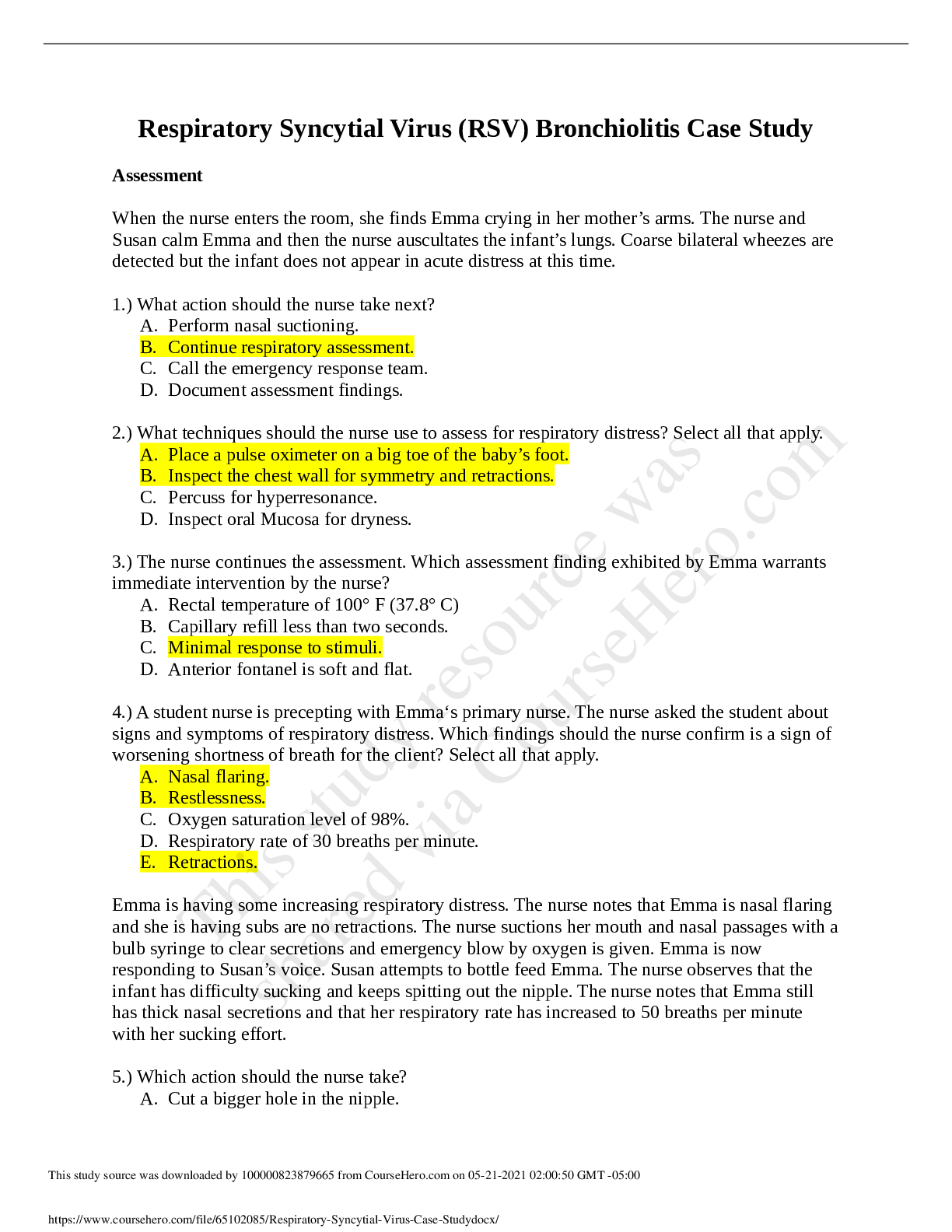
Reviews( 0 )
Document information
Connected school, study & course
About the document
Uploaded On
May 17, 2021
Number of pages
5
Written in
Additional information
This document has been written for:
Uploaded
May 17, 2021
Downloads
0
Views
35

.png)
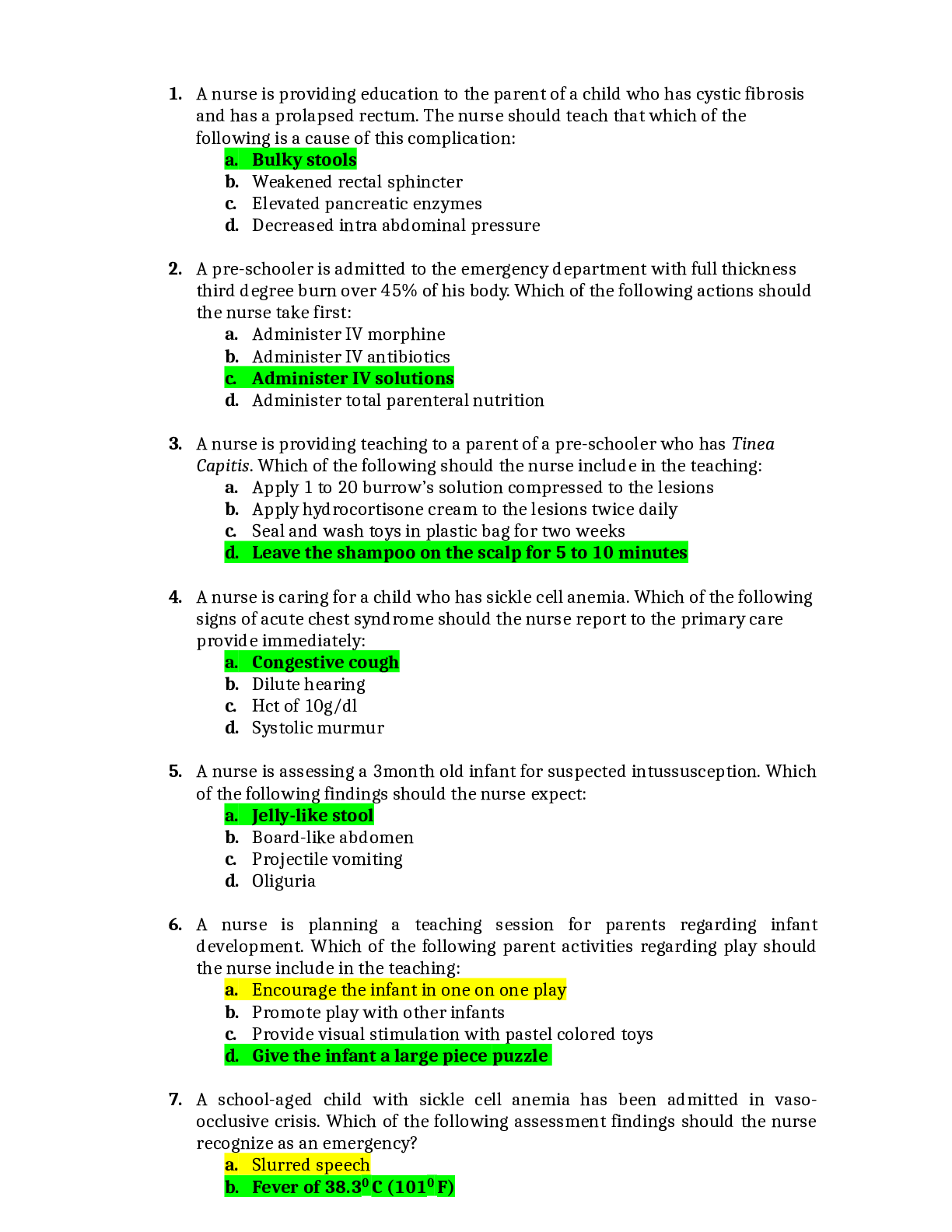


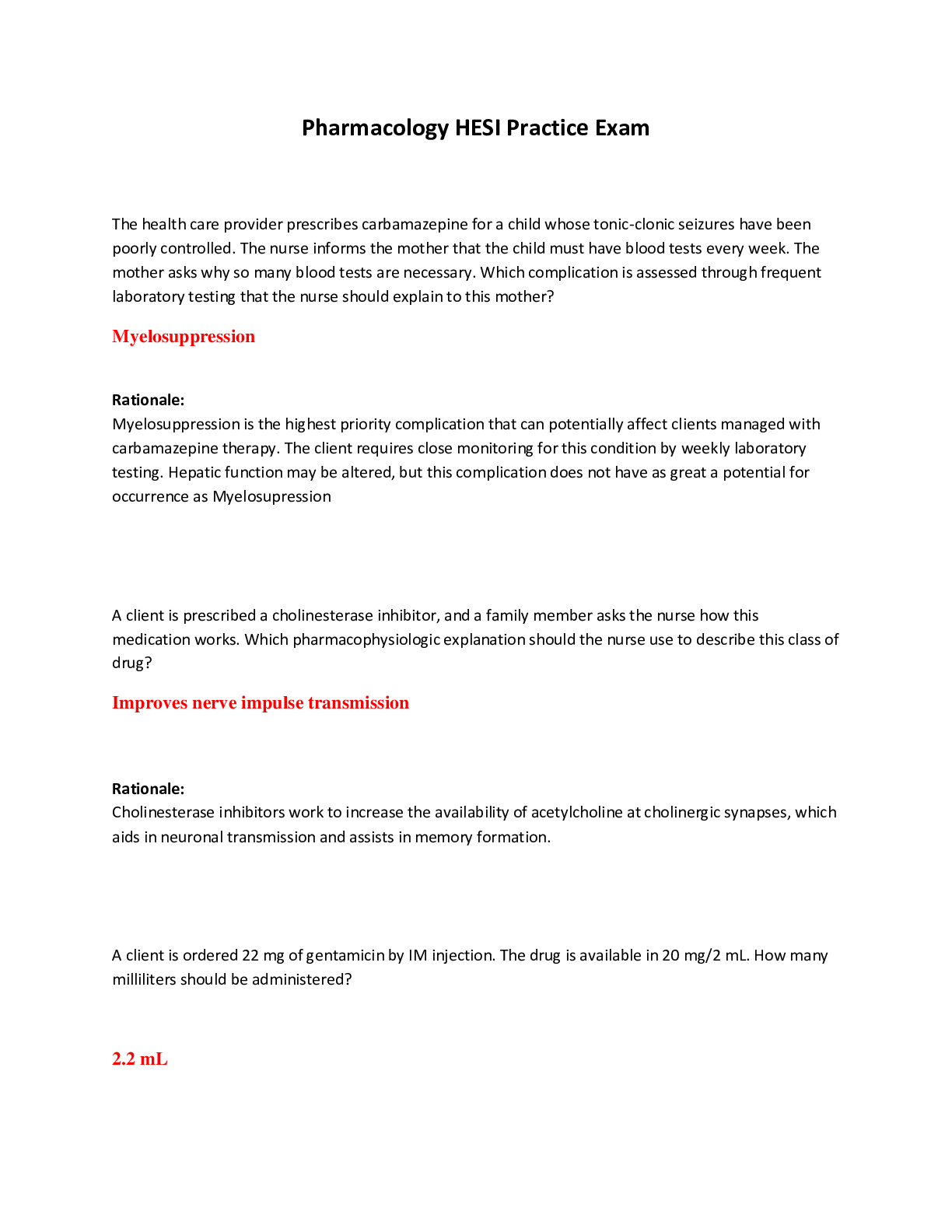


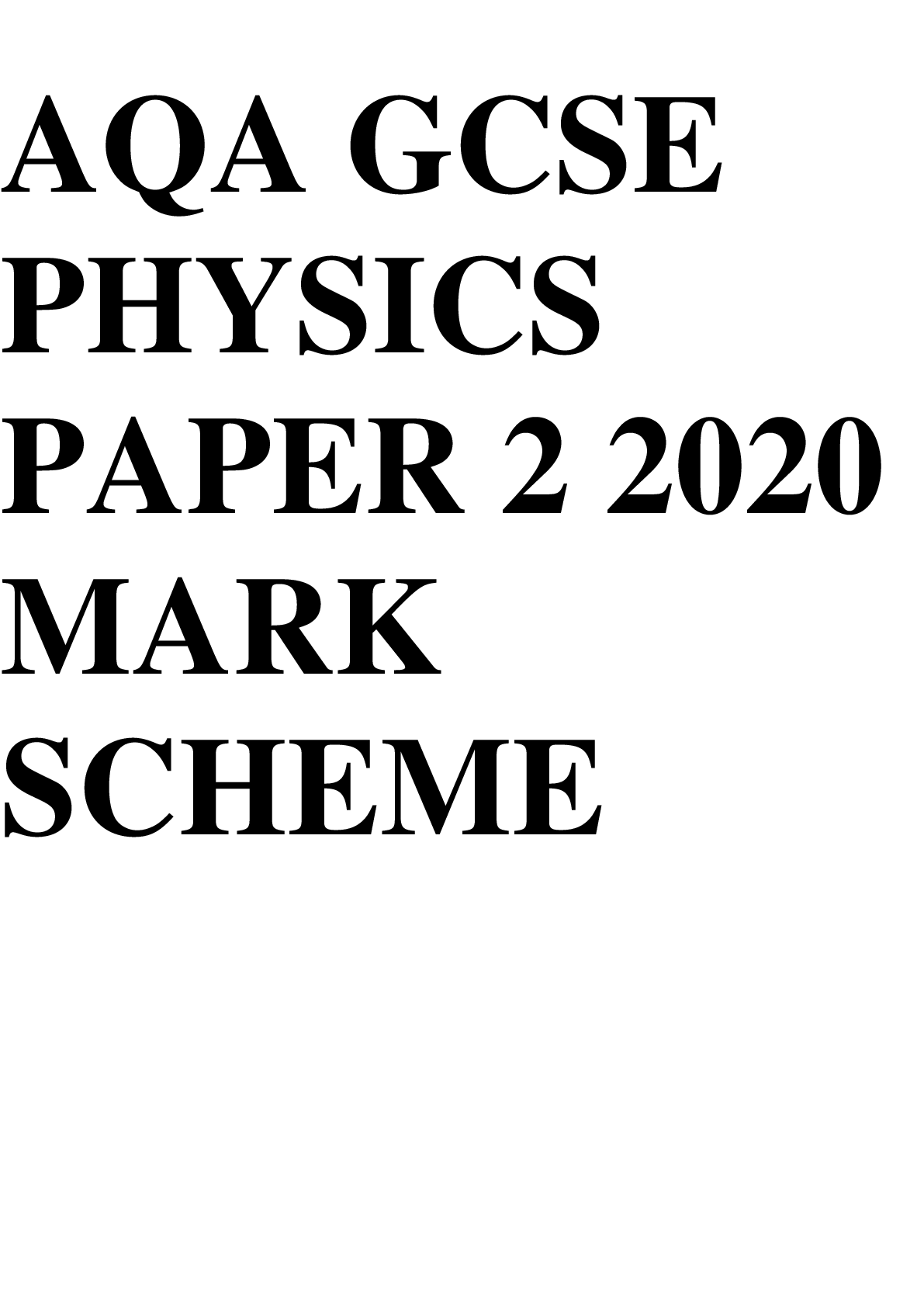

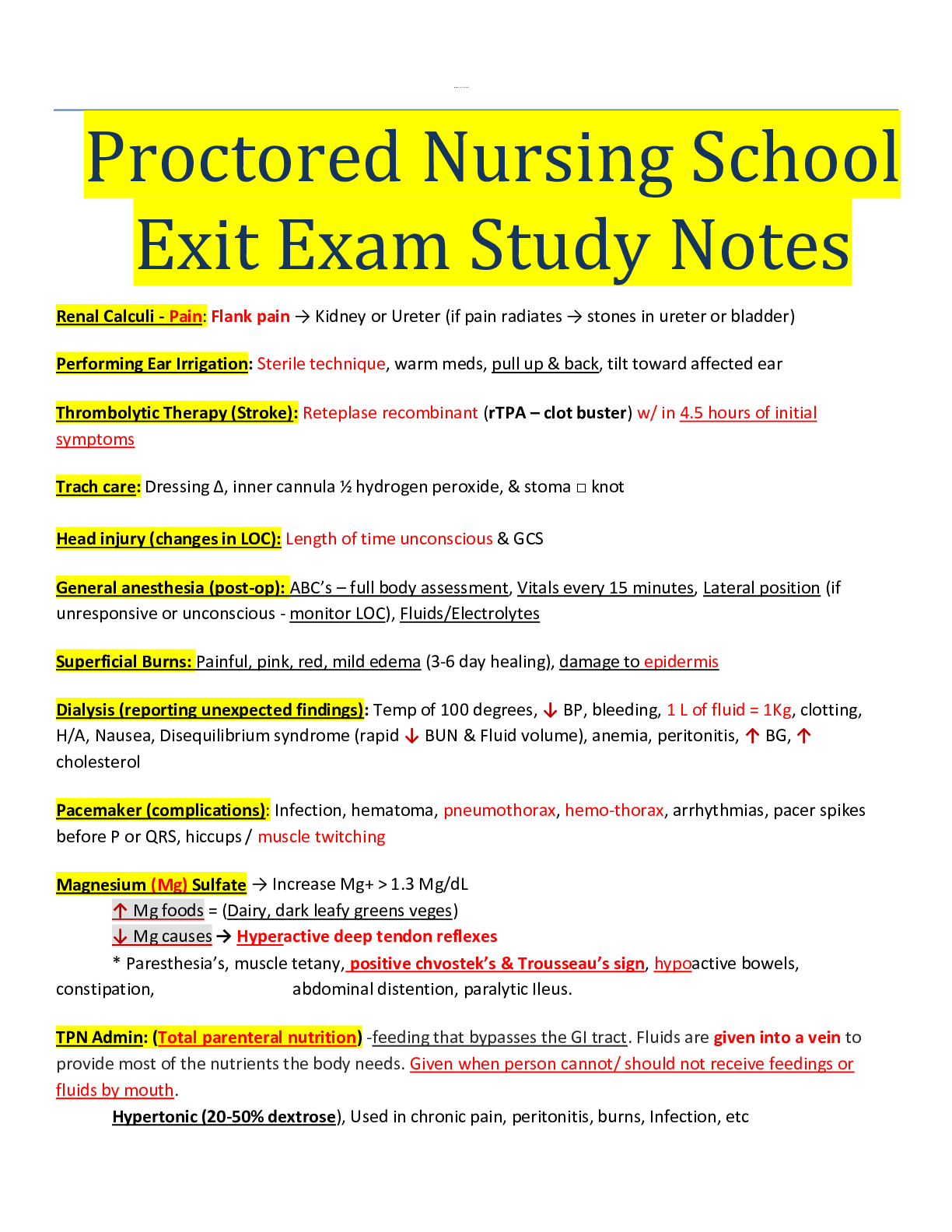
.png)
